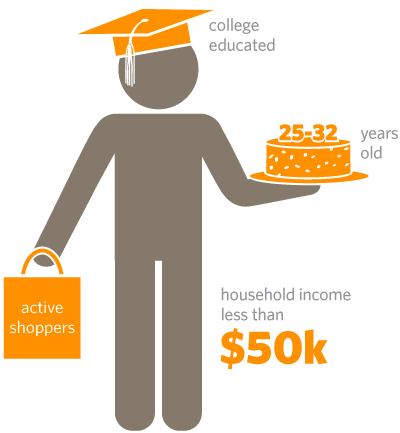Who Are These Purpose-Driven Consumers?
BLOG
BLOG

A new customer target audience-purpose-driven consumers—has entered the brand lexicon and is altering the marketing landscape.
This rising class of consumers uses its purchasing power to drive social and environmental change, representing both micro- and macro-economic dynamics. Consumers accomplish this by buying products with a purchase-level benefit to a cause (micro), by rewarding socially responsible brands with their ongoing loyalty (macro), or by doing both.
According to an international study fielded in late 2012, a majority of survey respondents—65%—feel an increasing sense of responsibility to purchase products that are good for the environment and society.


Research indicates that the tribe of purpose-driven consumers is large and in charge and gaining traction by the day. This scale is causing companies to consider “purpose” along with the rest of the P's in the marketing equation: price, place, product, and promotion.
But brands can't look at these consumers as one size fits all. There's a wide continuum of self-interest and other motivations driving these consumers, and you need to acknowledge these differences and be prepared to address disparate benefits.
As individuals, purpose-driven consumers are highly self-motivated, from their personal needs to their social desires. On the needs front, research shows that buy-one, get-one free remains a stronger motivator than buy-one, give one. This means your most powerful approach currently is to address self-interest first for the majority of the market. Beyond that, you then have the opportunity to help your customers actualize their dreams by enabling them to participate in creating social good.
In this relationship of fulfilling personal desires, you're not necessarily the good itself, but a fulcrum for achieving it. It's the consumer who gets to be the hero. As such, your brand becomes a way for people to increase their happiness through self-actualization and meaning, and your company derives profit from basking in the supporting role.

On the micro level, this might be expressed as buying products that are deemed friendly to the environment or that drive a positive social action. A high-profile example of the latter is TOMS shoes, which is a pioneer in the one-for-one movement. When you purchase a pair of shoes, TOM'S donates a pair to a child/person in need. Warby Parkerhas also pioneered this model for eyeglasses, among others in different sectors.
On the macro level, Patagonia comes to mind as a leading company that has prospered in a highly competitive industry for more than 40 years by actively demonstrating its corporate values for sustainability. Patagonia's customers feel good about forming a relationship with the outdoor clothing company. They know that their purchases go toward a larger good. And it adds convenience to their shopping by reducing the consideration set-why look at other brands with similar products when you can save time by buying from a brand you trust?
I believe this will increasingly be the case, where individuals will entrust and consolidate their purchasing power with brands they trust to act on shared values.
Much of this has happened because people now have the power in the brand relationship. They've obtained this power from the liberating aspects of the digital world, new-found social influence, and a desire to self-actualize their consumption via brands that enable them to do good.

Let's put a face on her.
That's right, she.
It's no wonder the personification of a purpose-driven consumer is female. Women donate, volunteer, and advocate for causes far more than men. They drive the dominant share of consumer spending, and they actually hold the majority of wealth in this country.
"Women give to causes close to their heart," says Lisa Dietlin, a Chicago-based philanthropic adviser.
More and more, women are spending their money with brands that are close to their heart and add social value to their purchase, creating a meaningful and potentially long-lasting relationship that is activated and maintained by social impact.
At the heart of this movement are women in the Millennial Generation. Here are some demographics from a research report published in 2013 conducted by Good Must Grow: Your purpose-driven customer is likely 25-32 years of age, has a college degree, and is an active shopper with a household income of less than $50,000. The bulk of the wealth might not reside here, but impetus for overall cultural change does. While they have less wealth and salary to spend, they are far more likely to consider a company's social behaviors or a product's ability to create positive change than other generations.
In part, that's because these women represent a generation that believes individuals are the number one way to drive positive change. This belief is supported by their digital lifestyle and social platforms, and fueled by generational mistrust of institutions.
Of course, not all purpose-driven consumers are female, and there's a spectrum of purposeful people that needs to be considered. Research conducted by GlobeScan, SustainAbility, and BBMG breaks out these customer segments as advocates, aspirationals, practicals, and indifferents:

Successful brands have always adapted to the times. If brands add purpose to their marketing efforts, they will avail themselves to a vertical market that's on its way to horizontal and mainstream, if it's not there already.
Brands must approach this opportunity as a long-term commitment that incorporates social cause into their values. This movement toward meaning will require structural change rather than a short-term cosmetic approach of new graphics or a feel-good tagline.
This isn't just about doing the right thing, though that's a good start if your efforts are to resonate with your customers. No, there's also tangible corporate reward for doing this beyond a sense of ethical good. Right now, consumers are telling you they have a genuine desire to bring meaning into every aspect of their lives, and they're looking for relationships with brands and nonprofit causes to help fulfill this. And to any marketing director worth their salt, this spells a profitable customer relationship built on brand loyalty.
Blog
Branding Magazine brings together four experts to discuss purpose-driven branding.
Blog
Let's go - we're building on our heritage and doubling down on purpose-driven work.
Blog
Our new white paper series is a blueprint for creating purpose-built companies.